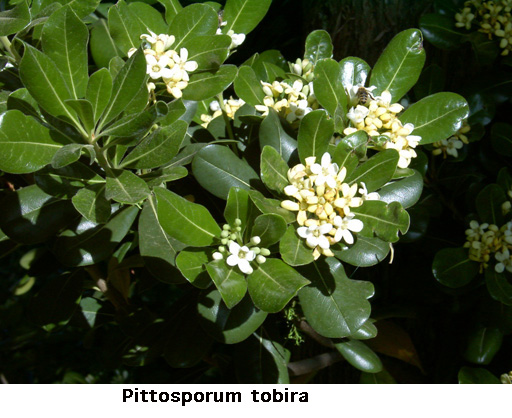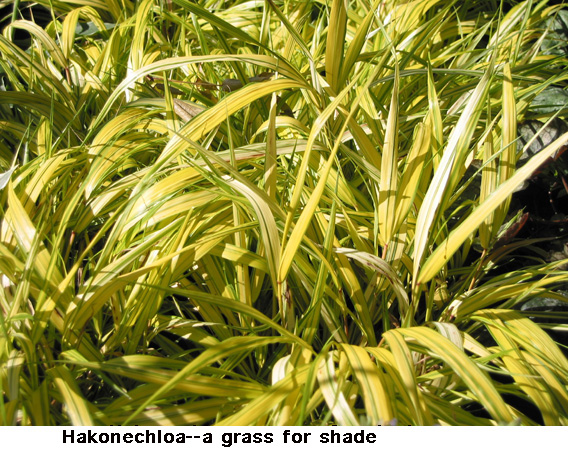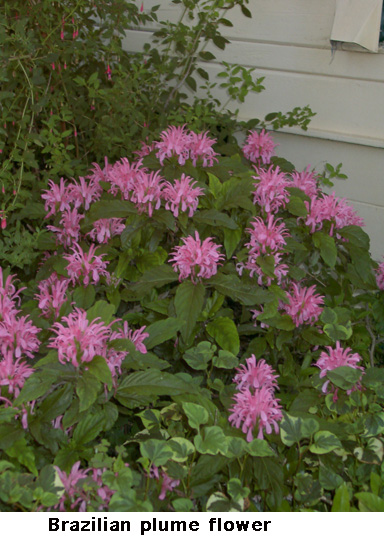Made for the Shade!
Written for the Davis Enterprise, May 23, 2002
Weather wimps, that's what we are!
When spring first lurks and then glimmers with hints of warm sun in February, we all rush out, peel off layers of winter clothing, and start planting flowers in the sunny spots in our garden. We grumble about every cloudy day (after all, we've had clouds and fog for weeks now!). Then on May 9 [2002] we hit 92F, and the whining begins again! "Ooh, it's so hot!" Out come the fans. Folks who've moved here from more benign climates such as the Bay Area or coastal Southern California are ready to pack it in (well, you ain't seen nothin' yet!). Of course, on May 12 it rained again, topping out at 67F--go figure. Nevertheless, the summer heat is just around the corner.
But Davis' wonderful canopy of shade trees is now in full leaf. Get your gardening done in the morning, pour a glass of cold water, and pull your garden chair under a tree or around to the east side of the house and admire the shady parts of your garden until our famous delta breeze air-conditions the Valley in the early evening.
The problem is, you've probably been neglecting the shady parts of your garden while you've been enjoying the spring sunshine. Things may be looking a little bare there. Early summer is a good time to focus on the shade garden, because with a little planning and planting it can become a pleasant and restful retreat during the hotter days ahead.
There's shade, and then there's sha-a-ade....The shade in your yard exists in microclimates--small areas that are affected by the placement of the house, a large tree, and shrubs. The time of day that sun strikes a plant can be crucially important here: morning sun (east) is benign, mid-day sun is tolerable, but most shade-preferring plants will be burned by sun after about 2 p.m. The density of the trees can make a big difference. Sycamore and plane trees (Platanus spp.) and Birch trees (Betula) cast a high dappled shade. Little blotches of sunlight may actually penetrate the canopy. Many plants prefer this bright shade. A fruitless mulberry (Morus alba) or a grove of redwoods (Sequoia sempervirens) creates deep shade--very pleasant on a hot summer day, but very difficult to garden under.
Other factors can increase the challenge. Aggressive roots of some trees compete with smaller plants for space and water. The steady leaf litter of evergreen trees can smother smaller plants if light raking isn't done regularly. A north exposure can be especially challenging, as the hottest sun of the day (late afternoon) at the hottest time of year (July) often peaks around the building and scorches foliage. While this leaf burn is cosmetic and not life threatening to the plant, it can certainly make it unsightly. Planting for a little additional shade from the west on a north side can make a big difference.
Shade can seem more of a challenge because there are fewer plants in our palette. This is when we reach beyond the plants native to our drier Mediterranean-style climate and look at species from higher-rainfall regions where shade is more common: woodland plants and subtropical plants. Where there's more rain, there's more shade--so there are more plants growing under trees that we can consider for our own landscapes. Keep in mind that your visual focus is lower in a canopy of shade than in an open, sunny garden--the high leaf canopy (or arbor) forces your line of sight downward, so the lower shrubs and ground-level perennials take on an added importance.
Your choice of foliage can make a big difference even in the absence of flowers. Bold, shiny leaves can create a tropical impression that is very useful around a hot tub or water feature, while feathery or variegated foliage can brighten a shade garden. Hardy philodendron (Philodendroun selloum), Japanese aralia (Fatsia japonica), and even the common Mock orange (Pittosporum tobira) are all large, easy shrubs with dark shiny leaves that glisten when wet. Lacy-textured leaves such as Heavenly bamboo (Nandina domestica) or non-invasive bamboo (Bambusa multiplex 'Fernleaf' or other varieties of this species) make a nice contrast with the darker larger leaves.

Grassy-textured plants (what landscape designers call "accent plants" can be planted just in front of the shrubs: Liriope muscari, especially the variegated forms, or a lovely garden grass with golden foliage and a mouthful of a name: Hakonechloa macra 'Aureola'. Hostas are accent plants that are very useful in the shade (bait for snails!); forms with white or gold variegation will be brighter and showier. The soft foliage of ferns naturally enhances the other plants. These groupings can be completed with low-growing ground covers such as Baby's tears (Soleirolia soleirolii--be careful! It's pretty invasive!), Vinca minor, Lamium maculatum, or Mondo grass (Ophiopogon japonicus).

This mix of plants can provide a background for flowering shade-lovers. Familiar perennials for brighter shade include Columbine (Aquilegia) and Coral bells (Heuchera). The latter now come in forms with strikingly variegated foliage, worth growing for the leaves as much as for the flowers. Taller subtropicals that give summer bloom in bright to moderate shade include Flowering maple (Abutilon), Fuchsias, and pink-flowered Brazilian plume flower (Justicia carnea; Jacobinia in older garden books). Clivia miniata has dramatic bright orange blooms and shiny dark green foliage and will grow even in deep shade.

There are some unusual plants that have distinctive foliage to use as a focal point. An unusual perennial called Toad lily (Tricyrtis hirta) has clean, attractive "woodsy" foliage, with pretty flowers in mid-summer as a nice bonus, and there's a golden-leafed variety called 'Golden Gleam.' The large, lobed leaves of two species of Hydrangea--H. arborescens and H. quercifolia--make a striking silhouette and the big flower clusters are reminiscent of the more familiar, fussier Garden hydrangea. Myers asparagus (A. densiflorus 'Myers') has soft green needles on dense fronds that are almost weird looking--a Dr. Seuss plant worthy of a special place. Sweet woodruff (Galium odoratum) is a low spreading perennial with nice shiny leaves and dainty white flowers, making a nice combination with other low ground covers.
Impatiens and fibrous begonias are the summer shade annuals. My experience has been that Impatiens does best in bright shade or morning sun and tends to stretch as the shade increases. Fibrous begonias are the most shade-tolerant summer flowers, although they can also take considerable sun. If invasive roots are a problem, begonias are especially effective planted in a color bowl when you mix the types with bronze and bright green leaves for contrast.

Choose your background shrubs for their foliage, spot in some accent plants, and tuck in some flowering perennials and annuals. Add a little moving water, and perhaps some wind chimes to signal the onset of the delta breeze--and you've got nothing to complain about this summer!
© 2008 Don Shor, Redwood Barn Nursery, Inc., 1607 Fifth Street, Davis, Ca 95616
www.redwoodbarn.com
Feel free to copy and distribute this article with attribution to this author.
Click here for Don's other Davis Enterprise articles
